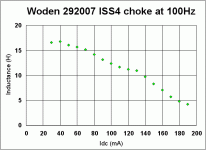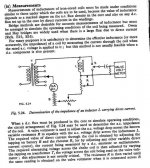Marconi TF2700 LCR bridge
Does anyone own this bridge?
I'd like to do some questions on this instrument.
Or better have the manual.
It looks like a good bridge and sold in a good price on e-bay.
I'm thinking seriously to buy one.............
Does anyone own this bridge?
I'd like to do some questions on this instrument.
Or better have the manual.
It looks like a good bridge and sold in a good price on e-bay.
I'm thinking seriously to buy one.............
wow I have posted this subject many days ago. Almost I forgot it!
And............. 🙂 an answer from a person I respect!
I'm missing a long time from the boards.But I remember you from the "tubes" section.
I don't have a bridge and there are a lot of times that I'd like to measure capacitance and impedance.
I'd like to know if it can measure choke and primary impedance of an OPT.
But my problem is to measure a choke, say at 50Hz and 200mA
an OPT at 20Hz and 50mA. Also does it apply any high voltage to the measured coil?
Not a problem if it needs an external signal generator or current source.
It will be helpfull if you can send me a copy of the Marconi's manual..... 😀
Thanks
And............. 🙂 an answer from a person I respect!
I'm missing a long time from the boards.But I remember you from the "tubes" section.
I don't have a bridge and there are a lot of times that I'd like to measure capacitance and impedance.
I'd like to know if it can measure choke and primary impedance of an OPT.
But my problem is to measure a choke, say at 50Hz and 200mA
an OPT at 20Hz and 50mA. Also does it apply any high voltage to the measured coil?
Not a problem if it needs an external signal generator or current source.
It will be helpfull if you can send me a copy of the Marconi's manual..... 😀
Thanks
You're very kind.
The TF2700 can measure:
Primary inductance of an output transformer.
Inductance of a choke with DC applied but it needs an external constant current source to apply the DC. It is also best if you give it an external source of AC so that it can measure smoothing chokes at 100Hz.
Air-cored crossover chokes (best done at 20kHz).
And it's very good for measuring capacitors (not so good for electrolytics).
There's really rather a lot of the manual, and scanning it would be a lot of work; just make sure you get a manual when you buy the bridge.
The TF2700 can measure:
Primary inductance of an output transformer.
Inductance of a choke with DC applied but it needs an external constant current source to apply the DC. It is also best if you give it an external source of AC so that it can measure smoothing chokes at 100Hz.
Air-cored crossover chokes (best done at 20kHz).
And it's very good for measuring capacitors (not so good for electrolytics).
There's really rather a lot of the manual, and scanning it would be a lot of work; just make sure you get a manual when you buy the bridge.
 yup the correct name is inductance!
yup the correct name is inductance!sorry but I'm not good with english.
So, with an external cs you can apply the desired mA.
And with an external source of AC you mean a signal generator?
What about voltage? Can you apply an external high voltage to the choke?
I'm not sure why you'd want to apply a high voltage to the choke (other than to check for breakdown) - it's a current dependent device.
Don't worry about your English, my French would have a Frenchman in tears.
Don't worry about your English, my French would have a Frenchman in tears.
Isn't better to measure it under conditions similar to which the choke is used.
I read this to Radiotron D Handbook.....
Do you have it? (pg250)
It says that "the value of inductance depends to a marked degree on the ac flux density in the core and also on any dc flux set up in the core by direct currents in the windings"
I read this to Radiotron D Handbook.....
Do you have it? (pg250)
It says that "the value of inductance depends to a marked degree on the ac flux density in the core and also on any dc flux set up in the core by direct currents in the windings"
You are absolutely right - a test should as closely as possible replicate the conditions of use. And as RDH4 says, the flux in the core of an inductor markedly changes the inductance, so you need to be able to vary that. But that's down to current not voltage. Here's one I measured earlier...
Attachments
I know that inductance changes with different applied currents but....................
Can you do a test with a constant current and a variable applied voltage?
Just to see the differences.If there are any!
I believe you but I'm just wondering what happans if the voltage is variable.
I don't have the instruments to check it.....
I thing I'll hit a Marconi TF2700 bridge! I like the old style design too! 😀
Can you do a test with a constant current and a variable applied voltage?
Just to see the differences.If there are any!
I believe you but I'm just wondering what happans if the voltage is variable.
I don't have the instruments to check it.....
I thing I'll hit a Marconi TF2700 bridge! I like the old style design too! 😀
that's a very nice question! 😀 I feel stupid!
ok that's not possible when measuring a choke with a bridge.
I had in mind the circuit in the RDH (pg250). Do you have the book or scan it and post it?
ok that's not possible when measuring a choke with a bridge.
I had in mind the circuit in the RDH (pg250). Do you have the book or scan it and post it?
I do have RDH4 but it's a bit difficult to get at just at the moment.
The person hasn't been born who hasn't asked a stupid question...
The person hasn't been born who hasn't asked a stupid question...
I'll post this in my signature! haha
when I'll have time I'll scan it and post it....................
when I'll have time I'll scan it and post it....................
Not to much difficult to build it!
What do you say? Or buy a Marconi bridge?
I allready own a Variac that I can use it at the place of the transformer. I only need the variable resistance and the variable current source.
What do you say? Or buy a Marconi bridge?
I allready own a Variac that I can use it at the place of the transformer. I only need the variable resistance and the variable current source.

It's not difficult to build, but it will be cumbersome. One problem that Langford-Smith didn't mention is that he's passing DC through his mains transformer. Most transformers don't like that and respond by saturating, distorting the AC waveform being applied to the choke, and causing a measurement error.
The Marconi bridge isn't very good at making inductance measurements of iron-cored inductors, but not because you can't apply DC (you can). The problem (and I was only made aware of this recently) is that it doesn't provide enough AC excitation, and that gives low readings. As an example, the same choke, with the same DC conditions, might only measure 12H on the Marconi, but 18H on an instrument capable of applying a larger AC excitation. You can't get around that with the Marconi because of the power limitation in one of the resistors in the bridge.
In the end, if you need to measure iron-cored chokes accurately at a specific AC and DC excitation, you need to build a custom jig. Rather than Langford-Smith's circuit, I would probably use a high compliance semiconductor cascode CCS to apply the DC, then apply the AC in parallel via a blocking capacitor and measure the AC current through the choke and the AC voltage across it.
The Marconi bridge isn't very good at making inductance measurements of iron-cored inductors, but not because you can't apply DC (you can). The problem (and I was only made aware of this recently) is that it doesn't provide enough AC excitation, and that gives low readings. As an example, the same choke, with the same DC conditions, might only measure 12H on the Marconi, but 18H on an instrument capable of applying a larger AC excitation. You can't get around that with the Marconi because of the power limitation in one of the resistors in the bridge.
In the end, if you need to measure iron-cored chokes accurately at a specific AC and DC excitation, you need to build a custom jig. Rather than Langford-Smith's circuit, I would probably use a high compliance semiconductor cascode CCS to apply the DC, then apply the AC in parallel via a blocking capacitor and measure the AC current through the choke and the AC voltage across it.
By measuring the AC current and the AC voltage I can calculate the Z of the choke? Am I right?
I'd like to build the custom jig
It'll be cheap and a nice instrument to have in my tiny lab!
Can you help me with the cascode CCS? Any circuit?
Can it be a simple LM317? 😕
Or it's a small semiconductor?
Right now I realized that with the same instrument I can measure the primary inductance of an OPT! That's awesome!
I'd like to build the custom jig

It'll be cheap and a nice instrument to have in my tiny lab!
Can you help me with the cascode CCS? Any circuit?
Can it be a simple LM317? 😕
Or it's a small semiconductor?
Right now I realized that with the same instrument I can measure the primary inductance of an OPT! That's awesome!
CCS
You could use the discrete transistor cascode CCS discussed in the tubes forum for which there might one day be PCBs. Alternatively, you could look at Walt Jung's recent AudioXpress CCS articles (which are available on the web). You need a CCS that can withstand quite a healthy voltage - probably over 100V.
Personally, I wouldn't use the 317. It's great for DC, but not so good as proving a high impedance at AC.
You could use the discrete transistor cascode CCS discussed in the tubes forum for which there might one day be PCBs. Alternatively, you could look at Walt Jung's recent AudioXpress CCS articles (which are available on the web). You need a CCS that can withstand quite a healthy voltage - probably over 100V.
Personally, I wouldn't use the 317. It's great for DC, but not so good as proving a high impedance at AC.
- Status
- Not open for further replies.
- Home
- Design & Build
- Parts
- Marconi TF2700 LCR bridge and measuring iron-cored chokes


